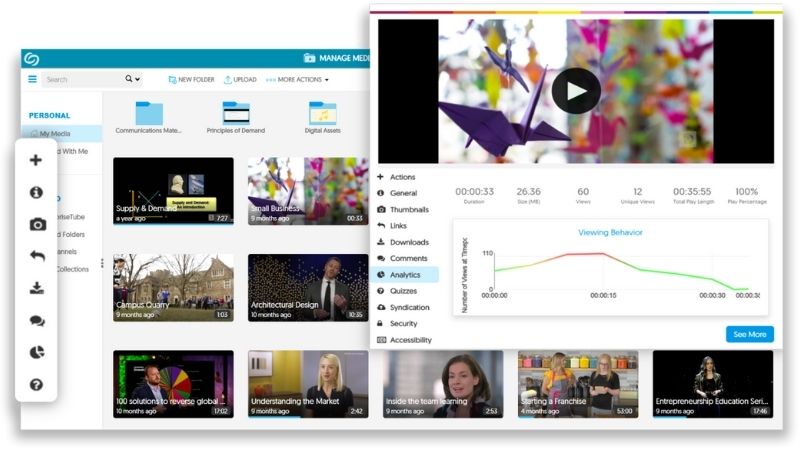
How many hours do you spend reading something daily? Now compare it with the time you spent watching videos.
For most people, the time spent watching a video would be significantly greater than the time they spent reading. The stark difference is because video content is far more engaging than any other type of content.
Video content involves two types of senses; auditory and visual senses. The video and sound grabs your attention instantly and also helps to effectively convey a message.
Did you know that 72% of customers prefer videos to learn about a product or service being offered? That means you have got an ever-evolving opportunity to entice your customers with videos that exhibit the value of a product or service.
This is because watching a video stays more interesting & enhances communication faster.
Furthermore, if you want to know about the magnitude of video content being uploaded and watched daily, here are some facts to give you an idea.
- One of the most popular video search engines, YouTube, reported over 2 billion monthly logged-in users.
- Over a billion hours of video content is watched on this platform daily.
- There are over 70 billion daily views on YouTube Shorts.
- The average visit length is around 11 minutes per visitor.
And the key highlights of these forecasted data let’s you know with…
The supply of video content is growing and it is now important to catch up with the demand for the same. In this article, we will discuss what exactly is Video Content Management System and the key features of a Video CMS.
What Exactly is Video Content Management System (Video CMS)?

A content management system is an application that allows you to efficiently organize, manage and distribute your media content including graphics, texts, videos, audios, etc.
To manage a large volume of video content being generated and watched daily, a robust video Content Management System (CMS) is needed. In the absence of a robust video CMS, you may find it difficult to search relevant content from the video library.
People who have a smaller video library might not feel an immediate need to install a video CMS solution. However, in case you have a big video library and are planning to add new content frequently, this will automatically ease your trouble of managing the content.
With the growth of video content, video CMS is being used by businesses and marketers to promote products and services. This creates a growing demand for Video CMS to centralize videos and manage different aspects of the same.
How Does Video CMS Work?
At the most basic level, the functionality of a video CMS application includes organizing, storing, and hosting video files in a library.
It allows you to store and view important video files, including raw and edited content, in a central location. Advanced video content management applications go a step further to help you sort files in order.
You can arrange the files as per different parameters including file size, topics, video equipment used for the shot, etc. This provides you with a simple way to search any particular file you need instantly.
For example, if you have created a video related to sports, you can type in the keyword ‘sports’ and easily find it out.
Key Features of a Video CMS

The exact set of features offered by a video CMS varies depending on the type of CMS you have opted for. Some video CMS might offer basic features that are handy for beginners, while others might provide you with an array of features to manage every aspect of your video content platform.
Let’s dive deeper into some of the essential features that a good video CMS must offer.
1. Bulk Uploading
The bulk uploading feature is a lifesaver for enterprise video management when you have a large video library that needs to frequently add new content. Uploading your video files individually can be a time-consuming process and also delays you’re editing work.
The bulk uploading tools allow you to easily upload numerous videos in comparatively less time and also save your bandwidth. Some video CMS applications also offer the auto pause and resume option to tackle internet speed fluctuations while uploading.
2. Scheduling
Scheduling your content in advance helps to save a great deal of time. The scheduling feature is very helpful when you want to upload time-sensitive content.
It gives you more flexibility by allowing you to automatically publish your page at a particular time. All online video management platforms must offer a content scheduling feature as timing plays a crucial role in the overall performance of your content.
3. Multi-Lingual Support
The multi-lingual support features offer an added advantage to reach and connect with local, regional and global audiences. This increases your reach and engagement rates to a great extent and also helps you build a regional audience base.
It is very effective in increasing your viewership, as your content won’t be limited to viewers that are familiar with a given language.
4. Drag and Drop
The drag and drop feature helps you to simply drag and upload a given content from your device folders or even third-party cloud platforms such as Google Drive, iCloud, Dropbox, etc. You can easily upload multiple contents at once without any glitches.
5. Multiple Media Formats
A dynamic CMS streaming solution must support multiple media formats when it comes to audio or video streaming. Some of the most commonly accepted formats include MP4, MP3, M4V, MPEG-DASH, H.265 Codec, etc.
6. User Management
The user management feature works on the principle of decentralization and delegation. You can provide authority & responsibility to a given user with rights to manage and control a particular aspect of your complete media library.
You can enable various user roles including publisher, content moderator, content administrator, etc.
Conclusion
A robust video content management system helps you build a dynamic video-on-demand platform. Video CMS helps to organize and manage different aspects of video content, in turn simplifying the navigation on your online portal.
Some of the key features that you should look for in a video CMS includes content scheduling, user management, drag, and drop option, bulk uploads, multiple media format support, etc.
One should always opt for a video CMS if they want to grow their video on demand solution and reach a large number of people globally.
